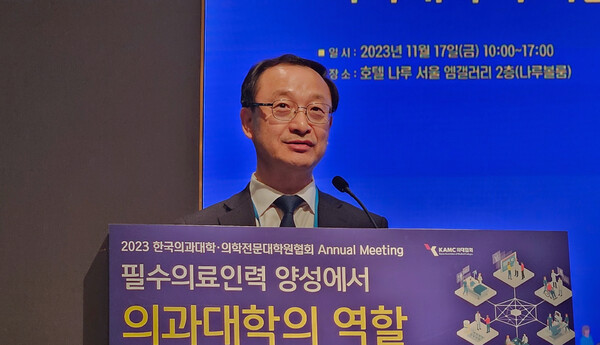
There still are various “theories” criculating regarding the size of the medical school enrollment quota increase, but the government has once again emphasized that “nothing has been finalized yet.”
At the annual meeting of the Korea Association of Medical Colleges (KAMC) on Friday, Jun Byung-wang, head of the Healthcare Policy Office at the Ministry of Health and Welfare, explained the government's policy direction for supporting essential medical care.
There have been speculations that medical school students could increase by up to 4,000. However, Jun brushed aside all such rumors. “The government has never talked about a number," Jun said. "There is no official number. The important thing is how many students each university will be able to accept."
The survey results on the demand for more medical students by universities, which were to be released this week, are "still being tallied," he added.
"Until Nov. 9, we conducted a demand survey to expand the number of medical school enrollment quota for each university in 2025,” he said. “However, we have received revised opinions, so we are still counting them and have not announced them. We plan to analyze the demand data submitted by Nov. 24."
Once the analysis is complete, the Medical Education Inspection Team will conduct a detailed evaluation and survey of each university.
"We will interview representatives from each university or visit the school site to confirm the feasibility of (the increase)," Jun said. “We plan to continue the survey until December and are utilizing the data from the training environment assessment."
Jun explained that the Healthcare Policy Review Committee would determine the final size. After discussions with the Korean Medical Association and the Medical Issues Council, the ministry will set the appropriate size for the final decision-making body, and the Education Ministry will conduct another demand survey and allocate seats to each school.
Expanding the number of medical students is one part of the overall essential medical care strategy. The government also doesn't believe that expanding the number of doctors alone will solve all the problems. However, if the physician workforce is not expanded, achieving the other essential healthcare strategies is difficult, he said.
"There is now a window of opportunity. We can increase the number of medical students and have come to replenish the infrastructure to do so. I think we can now create an environment where medical schools can properly educate students," he said. “Medical schools need to think about what direction they want to go (after the expansion)."
Related articles
- Korea leads OECD in per capita patient treatment, but the reality is complicated
- [Contribution] Korean healthcare policy is driven by ‘OECD ideology’
- Localities compete to secure increased medical school student quota
- Increasing doctors is no solution to essential care crisis: psychiatrists
- Universities want to add up to 4,000 medical students by 2030
- [Top 10 Healthcare News in 2023 ①] Korea to expand medical school quotas starting from 2025
- Doctors express ‘regret’ at reports on sharp increase in physicians

